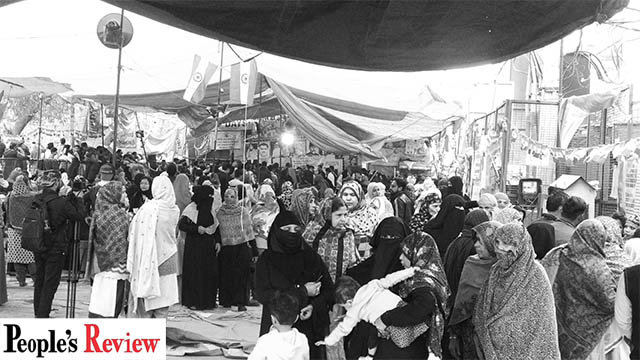The Supreme Court-appointed interlocutors, senior advocate Sanjay Hegde and Sadhana Ramchandran, reached Shaheen Bagh on 19 February 2020 afternoon to explore the scope of shifting their protest to an alternative site, most preferably to the isolated corner of Jantar Mantar, which is designated by the Indian state to gag the voices of dissent. The Supreme Court’s attempt to shift the Shaheen Bagh protest was declined by the overwhelming protesters. The women protesters of Shaheen Bagh collectively spoke in one voice, denouncing the proposal in the most polite way, telling the interlocutors that all they want is the government addressing their concerns first, treat them as people first, rather than vilifying them.
The women, including the famous Dadis of Shaheen Bagh (grandmothers of Shaheen Bagh), criticised Prime Minister Narendra Modi’s government, his deputy, the Union home minister, Amit Shah, the leaders of the ruling Bharatiya Janata Party (BJP) and its ideological mentor, the Rashtriya Swayamsevak Sangh (RSS), calling them the culprits of divisive politics. Through their highly emotive speeches, which touched the chords of thousands of people present at the site, these women of Shaheen Bagh declined the attempt to shift the Shaheen Bagh protest site.
All these women, mostly Pasmanda Muslims and one Hindu, lambasted the RSS-BJP’s vilification campaign, cited the threats under which they have been protesting, showed the deep injuries inflicted on the conscience of the marginalised people by the Modi regime’s Citizenship (Amendment) Act, 2019 (CAA) enactment, the forthcoming National Population Register (NPR), and the draconian National Register Citizens (NRC), which is mandated by the Citizenship (Amendment) Act, 2003. They asked why when the apex court can think of the inconvenience caused by the roadblock, which they claimed is only 150 metres on the road while the rest of the roads are blocked by the Delhi Police, why couldn’t the government think of the same and reach them at the spot. By emphasising the importance of protecting the constitution and the constitutional rights, the women claimed nothing can be more inconvenient than the fact that the country’s guiding ideology is under attack.
Both Hegde and Ramchandran promised to return the next day to hear more views. Their visit was followed by the visit of Wahjat Habibullah, who came to discuss the same topic with the protesters. He was also told politely by the protesters that the Supreme Court’s attempt to shift the Shaheen Bagh protest site isn’t acceptable to them because their voice won’t be heard elsewhere when it was not heard in Shaheen Bagh during the last 67 days. One of the women said that “while people go to Jantar Mantar in their youth, come out in their old age”.
The Supreme Court’s attempt to shift the Shaheen Bagh protest is done with the intention of helping big corporate honchos to travel faster between Delhi and Noida and not to provide the protesters with an option to raise their voice and show dissent without any fear. Showing excellent political maturity, insights and determination, the women protesters of Shaheen Bagh categorically made it clear that at no point in time they will give up their valiant movement on the very street of a locality, which from being an unknown Muslim ghetto in the southeastern corner of New Delhi has turned into the epicentre of anti-CAA-NPR-NRC movements. Hundreds of Shaheen Baghs are built on the theme of Shaheen Bagh, creating a massive chain of movements that oppose the Modi regime’s divisive agenda from Kolkata’s Park Circus to Allahabad’s Roshan Bagh to Chennai’s Washermanpet.
By resisting the attempt to shift the Shaheen Bagh protest site, the women protesters have clearly told the Indian ruling classes that their struggle to safeguard their constitutional rights, their right to exist, their perseverance to continue the movement until they compel the Modi regime to do away with its obnoxious agenda of creating a massive pool of stateless and bargaining power-less slaves for the corporate houses, is more important than opening a road, whose blockade is necessary to deliver the government a message that it needs to resolve the impasse by talking to the protesters, by providing them space to air their grievances and take affirmative actions accordingly. The Supreme Court’s interlocutor assignment is actually a subterfuge, and the women of Shaheen Bagh are determined that they will be able to show to the colonial-era state machinery and its institutions while thrashing their hubris, that it’s the people who are supreme in a republic and any attempt to undermine the people will cause a severe setback for the rulers.
An avid reader and a merciless political analyst. When not writing then either reading something, debating something or sipping espresso with a dash of cream. Street photographer. Tweets as @la_muckraker

